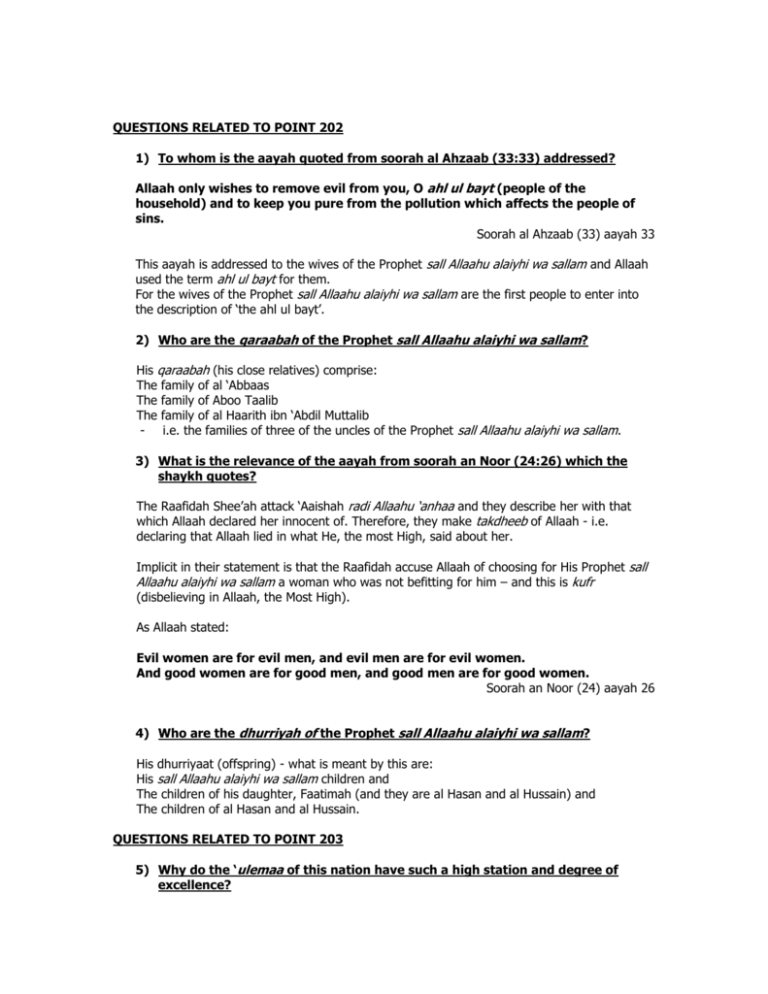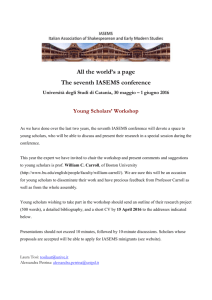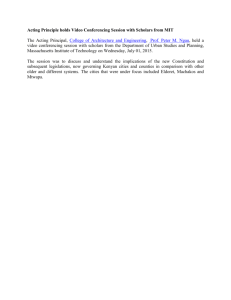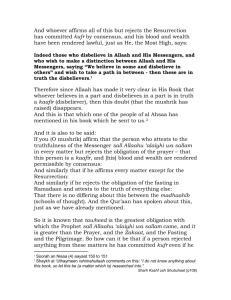QUESTIONS RELATED TO POINT 202
advertisement

QUESTIONS RELATED TO POINT 202 1) To whom is the aayah quoted from soorah al Ahzaab (33:33) addressed? Allaah only wishes to remove evil from you, O ahl ul bayt (people of the household) and to keep you pure from the pollution which affects the people of sins. Soorah al Ahzaab (33) aayah 33 This aayah is addressed to the wives of the Prophet sall Allaahu alaiyhi wa sallam and Allaah used the term ahl ul bayt for them. For the wives of the Prophet sall Allaahu alaiyhi wa sallam are the first people to enter into the description of ‘the ahl ul bayt’. 2) Who are the qaraabah of the Prophet sall Allaahu alaiyhi wa sallam? His qaraabah (his close relatives) comprise: The family of al ‘Abbaas The family of Aboo Taalib The family of al Haarith ibn ‘Abdil Muttalib - i.e. the families of three of the uncles of the Prophet sall Allaahu alaiyhi wa sallam. 3) What is the relevance of the aayah from soorah an Noor (24:26) which the shaykh quotes? The Raafidah Shee’ah attack ‘Aaishah radi Allaahu ‘anhaa and they describe her with that which Allaah declared her innocent of. Therefore, they make takdheeb of Allaah - i.e. declaring that Allaah lied in what He, the most High, said about her. Implicit in their statement is that the Raafidah accuse Allaah of choosing for His Prophet sall Allaahu alaiyhi wa sallam a woman who was not befitting for him – and this is kufr (disbelieving in Allaah, the Most High). As Allaah stated: Evil women are for evil men, and evil men are for evil women. And good women are for good men, and good men are for good women. Soorah an Noor (24) aayah 26 4) Who are the dhurriyah of the Prophet sall Allaahu alaiyhi wa sallam? His dhurriyaat (offspring) - what is meant by this are: His sall Allaahu alaiyhi wa sallam children and The children of his daughter, Faatimah (and they are al Hasan and al Hussain) and The children of al Hasan and al Hussain. QUESTIONS RELATED TO POINT 203 5) Why do the ‘ulemaa of this nation have such a high station and degree of excellence? This is because they are the warathat ul anbiyaa (the inheritors of the Prophets). The Prophet sall Allaahu alaiyhi wa sallam said: The scholars are the inheritors of the Prophets. Hadeeth of Aboo Dardaa radi Allaahu ‘anhu reported by al Bukhaaree in a mu’allaq form and declared saheeh by Shaykh al Albaanee rahimahumullaah. Indeed, the scholars come after the Companions in terms of their high station and excellence. 6) Who is meant by the term ‘ulemaa (scholars)? The ‘ulemaa are the ahl us Sunnah wal Jamaa’ah, the people of knowledge and discernment, the people of fiqh, the people of athar (narrations) – and they are the ahl ul hadeeth. 7) The ‘ulemaa can be divided into two categories. What is the first category and what kind of tasks do these scholars perform? The first category is the ‘ulemaa ul athar (the scholars of the narrations). They are the narrators and scholars of hadeeth. They gave great care to the Sunnah of the Prophet sall Allaahu alaiyhi wa sallam, they preserved it and defended it. These scholars put the Sunnah before the Muslim nation, pure and clear (from any alterations), just as it was spoken by Allaah’s Messenger sall Allaahu alaiyhi wa sallam. They kept the Sunnah far from every foreign matter which the people had tried to introduce into it as well as every lie. In addition, they put the fabricated ahaadeeth to one side; they clarified these and shut them off from the authentic Sunnah. 8) What is alternative name for these scholars? These scholars are known as the ‘ulemaa ul riwaayah (the scholars of narration). 9) What is the second category of scholars and what kind of tasks do these scholars perform? They are the fuqahaa (the scholars of fiqh). They are the ones who made istinbaat of the ahkaam (derived the rulings) from these evidences, and they clarified the knowledge contained in these evidences. These scholars explained them and clarified them to the people. 10) What is the alternative name for these scholars? They are also known as the ‘ulemaa ud diraaya (the scholars of understanding of the texts). 11) Do any scholars fall into both categories? What are these people known as? Yes, and they are known as the fuqahaa ul muhadditheen. 12) Which scholars does the shaykh quote who fell into both categories of scholar? Examples of the fuqahaa ul muhadditheen are: Imaam Ahmad, Maalik, ash Shaafi’ee and al Bukhaaree. 13) What types of matters have the scholars explained and clarified for the Muslim nation? They made clear the ahkaam (the rulings), the mawaareeth (laws of inheritance), and the halaal and haraam. They also explained the knowledge and understanding of the Book and the Sunnah. 14) What are the two types of fiqh? Fiqh (knowledge and understanding) is of 2 categories: a) al fiqh ul akbar (the greater fiqh) - and this is the fiqh of aqeedah b) fiqh ‘amalee – the fiqh relating to practical actions It should be noted that the second category is no less important than the first. 15) What two ahaadeeth does the shaykh quote to illustrate the excellence of the ‘ulemaa? The excellence of the scholar over the worshipper is like the excellence of the moon over the rest of the stars. Hadeeth reported by Imaam at Tirmidhee (no 2687) and authenticated by Shaykh al Albaanee. The excellence of the scholar over the worshipper is like my excellence over the lowest of you. Hadeeth reported by Imaam at Tirmidhee (no 2690) and authenticated by Shaykh al Albaanee. 16) Why do we not attack the scholars if they make mistakes? The scholars seek the Truth, but despite this, they do sometimes make mistakes. However they are still rewarded for these mistakes, as per the hadeeth of the Prophet sall Allaahu ‘alaiyhi wa sallam: If the judge strives to reach what is correct, and he attains what is correct, then there are two rewards for him. And if he strives and makes a mistake, then there is a single reward for him. Hadeeth reported by al Bukhaaree (no 7352) and Muslims.











